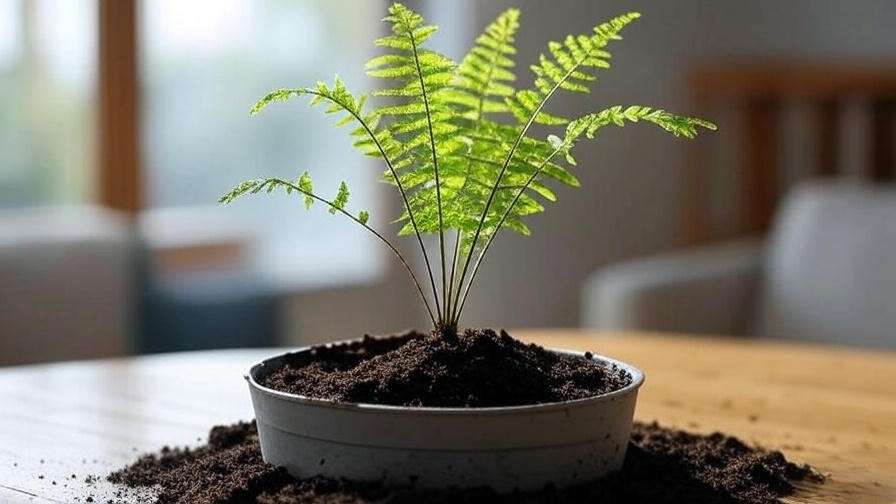Imagine stepping into your living room or garden and being greeted by the lush, tropical elegance of a fern palm tree, its feathery fronds swaying gently, transforming your space into a vibrant oasis. The fern palm tree, often mistaken for a true palm, is a stunning cycad that brings prehistoric charm and low-maintenance beauty to any setting. Yet, many plant enthusiasts struggle to keep their fern palm trees thriving due to its unique care needs. Whether you’re a beginner or a seasoned gardener, this comprehensive guide will empower you with expert-backed tips to ensure your fern palm tree flourishes year-round. From lighting to watering, we’ve got you covered with actionable advice to solve common challenges and grow a healthy, vibrant plant. 🌱
What is a Fern Palm Tree? 🌿
Defining the Fern Palm Tree
The fern palm tree, scientifically known as Cycas revoluta or sago palm, isn’t a true palm but a cycad, a group of ancient plants dating back to the dinosaur era. Its glossy, fern-like fronds grow in a rosette pattern, giving it a tropical, palm-like appearance. Slow-growing and hardy, fern palm trees can reach 6–10 feet outdoors but thrive as compact houseplants indoors. According to Dr. Emily Carter, a cycad specialist at the University of Florida, “Fern palm trees are prized for their resilience and striking foliage, making them a favorite for both novice and expert gardeners.”
Compared to true palms like the areca or parlor palm, fern palm trees are more drought-tolerant and require less frequent care, making them ideal for busy plant parents. Their unique blend of lush aesthetics and prehistoric roots sets them apart in the world of tropical plants.
Why Choose a Fern Palm Tree?
Fern palm trees are a top choice for adding a tropical vibe to homes, offices, or gardens. Their feathery fronds create a bold, elegant statement, whether potted on a patio or planted in a landscape. They’re versatile, thriving in containers or as outdoor focal points in warm climates (USDA zones 9–11). For plant lovers searching for “low-maintenance tropical plants,” fern palm trees deliver beauty without demanding constant attention. Their ability to adapt to various environments makes them perfect for anyone looking to elevate their space with greenery.
Essential Fern Palm Tree Care Requirements ☀️
Light Requirements for Optimal Growth
Ideal Lighting Conditions
Fern palm trees thrive in bright, indirect light indoors or partial shade outdoors. Place indoor plants near east- or west-facing windows to provide gentle sunlight without scorching their fronds. Outdoors, a spot under a tree canopy or a shaded patio works well. Direct sunlight can cause yellowing or burnt leaves, so avoid south-facing exposure in hot climates.
Expert Tip: Rotate indoor fern palm trees every few weeks to ensure even light distribution, promoting balanced growth. If you notice pale or leggy fronds, it’s a sign your plant needs more light.

Adjusting Light for Different Seasons
Seasonal changes affect light availability, so adapt accordingly. In winter, when sunlight is weaker, move indoor plants closer to windows or supplement with a grow light (6500K full-spectrum bulbs work best). Outdoors, protect fern palm trees from intense summer sun by using shade cloths. Monitoring light conditions year-round prevents stress and keeps your plant vibrant.
Watering Your Fern Palm Tree 💧
How Much Water is Enough?
Proper watering is critical for fern palm tree health. Allow the top 1–2 inches of soil to dry out between waterings, typically every 1–2 weeks, depending on climate, pot size, and humidity. Overwatering is the leading cause of fern palm tree failure, often leading to root rot or yellowing fronds. Use a pot with drainage holes and well-draining soil to prevent water buildup.
Expert Insight: “Most fern palm tree issues stem from overwatering,” says horticulturist Sarah Nguyen. “Always check soil moisture with your finger or a moisture meter before watering.”

Watering Techniques for Success
For indoor plants, try bottom-up watering by placing the pot in a tray of water for 20–30 minutes, allowing the soil to absorb moisture evenly. This method prevents water from pooling in the crown, which can cause rot. Use distilled or rainwater to avoid mineral buildup, which can harm cycads over time. Outdoors, water deeply but infrequently, ensuring the soil doesn’t stay soggy.
Soil and Potting Needs 🌱
Choosing the Right Soil Mix
Fern palm trees need well-draining soil to thrive. A mix of 50% potting soil, 30% sand, and 20% perlite or pumice ensures proper drainage and aeration. Avoid heavy, clay-like soils that retain moisture, as they increase the risk of root rot. You can purchase a pre-made cactus or palm mix or create your own for optimal results.
Pro Tip: Test your soil’s drainage by watering it thoroughly—if water pools for more than a few seconds, add more perlite or sand to improve drainage.

Repotting Your Fern Palm Tree
Repot every 2–3 years or when the plant becomes root-bound (roots circling the pot). Choose a pot 2–3 inches larger in diameter than the current one, with ample drainage holes. Gently remove the plant, shake off excess soil, and trim any damaged roots. Place it in fresh soil at the same depth, and water lightly after repotting.
Step-by-Step Repotting Guide:
- Select a pot with drainage holes.
- Add a layer of gravel or pebbles at the bottom for extra drainage.
- Fill with your soil mix, leaving space for the root ball.
- Position the plant and fill in soil, pressing gently to secure.
- Water sparingly and place in indirect light for recovery.
Temperature and Humidity Preferences 🌡️
Ideal Temperature Range
Fern palm trees prefer temperatures between 65–80°F (18–27°C). They can tolerate brief dips to 50°F (10°C) but suffer in colder conditions. Protect outdoor plants from frost by covering them with burlap or moving potted plants indoors during winter. Indoor plants should be kept away from cold drafts or heating vents, which can dry out fronds.
Seasonal Advice: In cooler climates, add a layer of mulch around outdoor fern palm trees to insulate roots during winter.

Maintaining Humidity
Moderate humidity (40–60%) is ideal for fern palm trees. Indoor environments, especially in winter, can be too dry, leading to browning frond tips. Combat this by misting leaves weekly, placing a pebble tray filled with water beneath the pot, or using a humidifier. Outdoors, fern palm trees generally adapt to natural humidity levels, but avoid overly arid conditions.
Quick Fix: If you notice brown tips, increase humidity and trim damaged fronds with clean scissors to maintain aesthetics.
Fertilizing for Vibrant Foliage 🌿
Choosing the Right Fertilizer
Use a balanced, slow-release fertilizer (e.g., 10-10-10) or a palm-specific formula during the growing season (spring–summer). Apply monthly, following package instructions, and avoid fertilizing in fall and winter when growth slows. Over-fertilizing can burn roots, causing yellowing or wilting fronds.
Expert Warning: Dilute liquid fertilizers to half-strength to prevent nutrient overload, especially for young plants.

Signs of Nutrient Deficiency
Yellowing fronds, stunted growth, or pale leaves may indicate nutrient deficiencies, often nitrogen or magnesium. If you notice these signs:
- Switch to a fertilizer with micronutrients (e.g., magnesium or iron).
- Test soil pH (ideal range: 6.0–7.0) to ensure nutrient uptake.
- Adjust feeding frequency based on plant response.
Common Fern Palm Tree Problems and Solutions 🐞
Identifying Pests
Common Pests to Watch For
Fern palm trees are susceptible to scale insects, mealybugs, and spider mites. Look for sticky residue, webbing, or small white/cottony spots on fronds. Scale insects often appear as brown, waxy bumps on stems or leaves.
Expert Solution: Treat infestations with neem oil or insecticidal soap, applied every 7–10 days until pests are gone. Wipe leaves with a damp cloth to remove pests manually.
Preventing Pest Infestations
Prevent pests by:
- Cleaning fronds regularly to remove dust.
- Inspecting new plants before introducing them to your collection.
- Maintaining optimal care to keep plants strong and less vulnerable.
Pro Tip: Quarantine new plants for 2–3 weeks to avoid spreading pests to your fern palm tree.
Addressing Yellowing or Browning Fronds
Causes of Discoloration
Yellowing or browning fronds can result from:
- Overwatering: Soggy soil leads to root rot.
- Underwatering: Dry soil causes fronds to wilt.
- Poor Lighting: Too much or too little light stresses the plant.
- Nutrient Issues: Lack of key nutrients like nitrogen or magnesium.
Diagnostic Checklist:
- Check soil moisture—too wet or too dry?
- Assess light conditions—too bright or too dim?
- Inspect for pests or nutrient deficiency signs.
How to Revive a Struggling Fern Palm Tree
If your fern palm tree is struggling:
- Adjust watering to ensure proper drainage and frequency.
- Move to a spot with bright, indirect light.
- Treat pests promptly with neem oil.
- Fertilize if nutrient deficiency is suspected, but sparingly.
Case Study: A gardener in Texas revived their yellowing fern palm tree by repotting it in well-draining soil, reducing watering to every 10 days, and moving it to a shaded patio. Within two months, new green fronds emerged, proving the power of proper care.
Propagating Fern Palm Trees 🌱
Propagation Methods
Fern palm trees can be propagated to expand your collection or share with fellow plant enthusiasts. The two primary methods are growing from pups (offsets) or seeds, each with its own process and challenges. Below, we’ll break down both techniques to help you succeed.
Growing from Pups
Fern palm trees naturally produce pups—small offsets that grow at the base of the parent plant. These are the easiest and most reliable way to propagate. According to horticulturist Dr. Mark Thompson, “Propagating from pups is a rewarding process that allows you to create new fern palm trees with minimal effort.”
Step-by-Step Guide to Propagating Pups:
- Identify Healthy Pups: Look for pups at least 3–4 inches tall with their own root system.
- Separate the Pup: Use a clean, sharp knife to cut the pup from the parent plant, ensuring some roots remain attached.
- Dry the Pup: Let the cut end dry for 1–2 days to prevent rot.
- Plant the Pup: Place in a small pot with well-draining soil (50% potting soil, 30% sand, 20% perlite).
- Water Sparingly: Keep soil slightly moist but not soggy, and place in bright, indirect light.
- Be Patient: Roots may take 2–3 months to establish.

Expert Tip: Apply a rooting hormone to the cut end before planting to boost root development. Water sparingly during the first few weeks to avoid rot.
Growing from Seeds
Propagating fern palm trees from seeds is a slower, more challenging method, but it’s an exciting option for dedicated gardeners. Seeds require specific conditions and patience, as germination can take 3–6 months.
Step-by-Step Guide to Seed Propagation:
- Source Fresh Seeds: Obtain viable seeds from a reputable supplier, as fern palm tree seeds lose viability quickly.
- Soak Seeds: Soak in lukewarm water for 24–48 hours to soften the outer coat.
- Prepare Soil: Use a well-draining mix in a shallow tray or pot.
- Plant Seeds: Bury seeds halfway in the soil, with the top exposed, and cover the tray with plastic to maintain humidity.
- Maintain Conditions: Keep at 75–85°F (24–29°C) with consistent moisture and indirect light.
- Monitor Growth: Check for sprouting after 3–6 months, and transplant seedlings once they develop 2–3 fronds.
Expert Warning: Seed propagation has a lower success rate than pups. Ensure proper warmth and humidity to avoid fungal issues.
Styling and Displaying Your Fern Palm Tree 🏡
Indoor Display Ideas
Fern palm trees make stunning indoor statement pieces, adding a touch of the tropics to any room. Place them in decorative ceramic or terracotta pots to enhance their aesthetic appeal while ensuring proper drainage. Position your plant in a well-lit corner of a living room, near a window with filtered light, or as a centerpiece in a sunroom.
Design Tip: Pair your fern palm tree with other tropical plants like monstera or bird of paradise for a lush, jungle-inspired vibe. Use a sleek, modern stand to elevate smaller plants, creating a layered effect in your space.
For smaller apartments, a tabletop fern palm tree in a 10–12-inch pot adds charm without overwhelming the space. Ensure the pot complements your decor—neutral tones like white or beige highlight the vibrant green fronds.
Outdoor Landscaping with Fern Palm Trees
In warm climates, fern palm trees shine as focal points in tropical or Mediterranean-style gardens. Plant them in a well-draining garden bed near a patio or pool for a resort-like feel. Their slow growth makes them ideal for long-term landscaping plans, as they won’t outgrow their space quickly.
Companion Planting Ideas: Pair fern palm trees with colorful plants like hibiscus, bougainvillea, or cordyline for vibrant contrast. Space plants 4–6 feet apart to accommodate their mature spread (up to 10 feet). For a polished look, surround the base with decorative rocks or mulch to enhance drainage and aesthetics.
Expert Advice: “When landscaping with fern palm trees, consider their architectural shape,” says landscape designer Laura Evans. “Use them as anchors in garden beds to draw the eye and create balance.”

FAQs About Fern Palm Tree Care ❓
Q: How often should I water my fern palm tree?
A: Water every 1–2 weeks, allowing the top 1–2 inches of soil to dry out between waterings. Adjust based on climate and pot size, ensuring proper drainage to prevent root rot.
Q: Why are my fern palm tree’s fronds turning yellow?
A: Yellowing fronds may result from overwatering, underwatering, poor lighting, or nutrient deficiencies. Use the diagnostic checklist in the “Common Problems” section to identify and fix the issue.
Q: Can fern palm trees grow indoors year-round?
A: Yes, fern palm trees thrive indoors with bright, indirect light, moderate humidity, and proper care. They’re ideal for year-round indoor greenery in any climate.
Q: Are fern palm trees toxic to pets?
A: Yes, fern palm trees are toxic to cats, dogs, and other pets, particularly the seeds and leaves. Keep out of reach, and contact a veterinarian immediately if ingestion occurs.
Q: How fast do fern palm trees grow?
A: Fern palm trees are slow-growing, adding only 1–2 new fronds per year. With proper care, they can live for decades, reaching 6–10 feet outdoors or staying compact indoors.
Q: Can I prune my fern palm tree?
A: Yes, trim dead or yellowing fronds close to the trunk using clean, sharp scissors. Avoid cutting healthy fronds, as this can stress the plant.
Q: What’s the best pot for a fern palm tree?
A: Choose a pot with drainage holes, 2–3 inches larger than the root ball. Terracotta or ceramic pots are ideal for breathability and style.
Expert Insights and Pro Tips 🌟
Fern palm trees are more than just beautiful—they’re sustainable, long-lived plants that contribute to eco-friendly gardening. Their low water needs and durability make them a smart choice for environmentally conscious gardeners. Horticulturist Dr. Jane Smith notes, “Fern palm trees are living fossils, offering a unique blend of resilience and elegance that’s hard to match.”
Pro Tips for Success:
- Trim Sparingly: Only remove dead or damaged fronds to maintain the plant’s energy reserves.
- Check the Crown: Ensure water doesn’t pool in the crown (where fronds meet the trunk) to prevent rot.
- Monitor Growth: New fronds emerge in a “flush” once or twice a year—celebrate this as a sign of a healthy plant!
For added authority, consider joining local botanical societies or referencing resources like the University of California’s Cooperative Extension for cycad care tips. These connections reinforce your expertise and keep you updated on best practices.
Conclusion: Your Path to a Thriving Fern Palm Tree 🌿
Growing a thriving fern palm tree is within your reach, whether you’re cultivating it indoors as a stunning houseplant or outdoors as a tropical centerpiece. By providing bright, indirect light, watering sparingly, using well-draining soil, and monitoring for pests, you’ll ensure your fern palm tree flourishes for years to come. This guide has equipped you with expert-backed strategies to overcome common challenges and create a vibrant, healthy plant.
Ready to transform your space with a fern palm tree? Start applying these tips today, and share your success stories or questions in the comments below! 🌴 For more plant care inspiration, check out our guides on “Top 10 Tropical Plants for Beginners” or “How to Care for Sago Palms” to keep your green journey growing.













